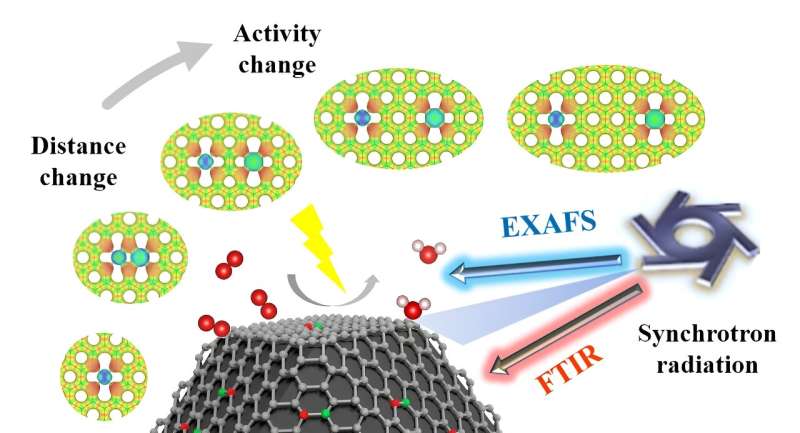This article has been reviewed according to Science X's editorial process and policies. Editors have highlighted the following attributes while ensuring the content's credibility:
fact-checked
trusted source
proofread
Regulating atomic Fe-Rh site distance for efficient oxygen reduction reaction

In a study published in the journal Science China Chemistry, the authors systematically design and investigate the site-distance effect of Fe-Rh atom catalysts (Fe-Rhx@NC) supported by N-doped graphene for ORR by an integrated theoretical and experimental approach.
By using electrostatic potential (ESP) and Bader charge analysis, theoretical calculations predict that the site-distance effect changes the catalytic, electronic structure of different Fe-Rh atomic site distances (dFe-Rh), optimizing the adsorption strength of the catalyst.
Consequently, motivated by these theoretical calculations, the authors designed the Fe-Rhx@NC catalysts through a spatial confinement strategy and synthesized the Fe-Rhx@NC catalysts with different dFe-Rh.
High-angle toroidal dark field scanning TEM (HAADF-STEM) images further demonstrate the successful synthesis of catalysts at different Fe-Rh atomic distances. X-ray photoelectron spectroscopy (XPS) and X-ray absorption spectroscopy (XAS) demonstrated the effect of site distance on the strength of interaction between Fe and Rh.
The Fe-Rh2@NC has the optimal atomic distance to provide the most positive onset potential (Eonset) and a half-wave potential (E1/2) of 1.01 and 0.91 V vs. RHE as compared to Fe-Rh1@NC (0.96 and 0.88 V) and Fe@NC (0.96 and 0.87 V), even higher than commercial Pt/C (0.98 and 0.86 V).
Density functional theory (DFT) calculations reveal that Fe-Rh2@NC can interact with O2 moderately, with suitable adsorption energy, conducive to promoting the kinetic process of ORR. Compared with Fe@NC, the Fe-Rh2@NC catalyst has a higher projected state density near the Fermi level, indicating that the Fe-Rh2@NC bimetallic catalyst has stronger electron transfer ability and higher catalytic performance.
Associate Researcher Ding Tao and Professor Yao Tao, University of Science and Technology of China led this study. The experiments were performed by density functional theory calculation and synchrotron radiation characterization techniques.
More information: Tong Liu et al, Regulating atomic Fe–Rh site distance for efficient oxygen reduction reaction, Science China Chemistry (2024). DOI: 10.1007/s11426-023-1889-6
Provided by Science China Press





















